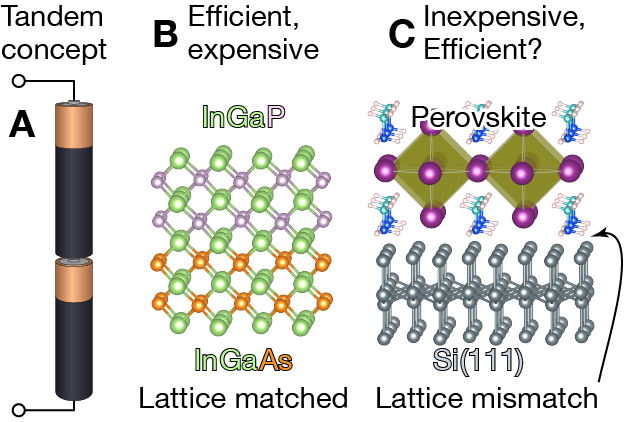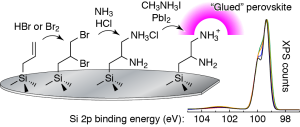 Tandem-junction solar cells can be highly efficient when they stack complementary solar absorber materials in the same way that we “stack” batteries to get a higher voltage (A). While this is responsible for the high efficiencies of multifunction III-V solar cells (B) where certain combinations are perfectly lattice-matched to each other. However, the materials that might become part of inexpensive tandem-junction solar cells could end up being wildly different from each other (C). These materials may have crystal structures that don’t align with each other. Misaligned atoms means chemical defects, chemical defects mean electronic defects, and electronic defects are bad for harvesting solar energy, m’kay?
Tandem-junction solar cells can be highly efficient when they stack complementary solar absorber materials in the same way that we “stack” batteries to get a higher voltage (A). While this is responsible for the high efficiencies of multifunction III-V solar cells (B) where certain combinations are perfectly lattice-matched to each other. However, the materials that might become part of inexpensive tandem-junction solar cells could end up being wildly different from each other (C). These materials may have crystal structures that don’t align with each other. Misaligned atoms means chemical defects, chemical defects mean electronic defects, and electronic defects are bad for harvesting solar energy, m’kay?
Organic monolayers are uniquely positioned to chemically bond to each material, be electrically conductive, and have tunable energy levels to enable carrier selectivity. Challenges lie in attaching the organics correctly, understanding how each layer affects the electronic properties of adjacent laters, and putting the second absorber material on top of the organic layer in a way that doesn’t wreck everything.
Here are some papers that we have recently published in this area:
 Open-Circuit Photovoltage Exceeding 950 mV with an 840 mV Average at Sb2S3–Thianthrene+/0 Junctions Enabled by Thioperylene Anhydride Back Contacts.
Open-Circuit Photovoltage Exceeding 950 mV with an 840 mV Average at Sb2S3–Thianthrene+/0 Junctions Enabled by Thioperylene Anhydride Back Contacts.
Curtis W. Doiron, Nicholas A. Fitzpatrick, Clare P. Masucci, Julia L. Martin, Alexander D. Carl, and Ronald L. Grimm
ACS Omega, 2020, 5, 16875–16884.
10.1021/acsomega.0c02077
 Covalent Attachment and Characterization of Perylene Monolayers on Si(111) and TiO2 for Electron-Selective Carrier Transport.
Covalent Attachment and Characterization of Perylene Monolayers on Si(111) and TiO2 for Electron-Selective Carrier Transport.
Alexander D. Carl and Ronald L. Grimm
Langmuir, 2019, 35(29), 9352–9363.
10.1021/acs.langmuir.9b00739
 Synthesis and Characterization of Alkylamine-Functionalized Si(111) for Perovskite Adhesion with Minimal Interfacial Oxidation or Electronic Defects.
Synthesis and Characterization of Alkylamine-Functionalized Si(111) for Perovskite Adhesion with Minimal Interfacial Oxidation or Electronic Defects.
Alexander D. Carl, Roghi E. Kalan, John David Obayemi, Martiale Gaetan Zebaze Kana, Winston Oluwole Soboyejo, and Ronald L. Grimm.
ACS Appl. Mater. Interfaces, 2017, 9(39), 34377-34388. 10.1021/acsami.7b07117

 Research
Research
 Energy
Energy
 People
People